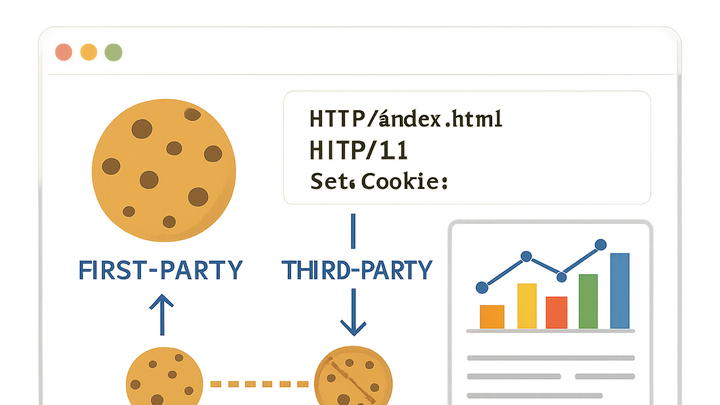Published on 2025-06-28T03:49:09Z
What are Cookies in Analytics? Examples and Usage
Cookies are small text files stored in a user’s browser that hold key–value data for identifying and tracking user interactions. In analytics, cookies assign unique identifiers to visitors, enabling tools to distinguish between new and returning users, measure sessions, and track engagement across pages. They can persist data like user preferences, consent status, and attribution parameters. However, cookies also raise privacy concerns and are subject to regulations like GDPR and CCPA. As browsers phase out third-party cookies and users demand greater privacy, analytics teams must balance data accuracy with compliance and explore cookie-free alternatives.
Cookies
Cookies are small browser files that store identifiers to track user sessions and behavior in analytics, with privacy and compliance considerations.
Overview of Cookies in Analytics
Cookies are small text files that store key–value pairs in a browser. In web analytics, they assign unique IDs to visitors, track sessions, and record pageviews. By persisting identifiers, cookies enable analytics tools to build user journeys, measure engagement, and attribute conversions. While invaluable for insights, cookies face challenges from privacy regulations and browser restrictions, making alternative tracking methods increasingly relevant.
-
Definition
In analytics, a cookie is a small piece of data stored on the client side that assigns a unique ID to a user’s browser.
-
Purpose in analytics
Cookies help identify users, track sessions, measure engagement, and attribute conversions across web pages and visits.
How Cookies Work
Cookies operate via HTTP headers or JavaScript and travel with each matching request, enabling stateful interactions in stateless HTTP. They have defined scopes (domain, path) and lifespans (session or persistent). Understanding these mechanics is crucial for correct implementation and regulatory compliance.
-
Cookie creation
Cookies can be set using the
Set-CookieHTTP response header or via JavaScript (document.cookie). Once set, browsers include cookies in subsequent requests matching the defined scope.-
Http headers
Server responses include
Set-Cookieheaders specifying name, value, domain, path, expiry, and security flags. -
Client-side scripting
Scripts use
document.cookie = 'name=value; expires=...; path=...';to create or modify cookies dynamically.
-
-
Scope and lifespan
The
domainandpathattributes determine which pages send the cookie. Theexpiresormax-ageattribute defines persistence, distinguishing session cookies from persistent cookies.-
Session cookies
Deleted when the browser session ends.
-
Persistent cookies
Remain until a set expiration date or user clears them.
-
Types of Cookies
Cookies vary by duration, purpose, and security. Common categories include session vs persistent, secure vs HttpOnly, and SameSite settings. Each type has implications for data integrity, user experience, and privacy compliance.
-
Session cookies
Temporary cookies that last only for the duration of a browser session.
-
Persistent cookies
Cookies that remain on users’ devices until they expire or are manually deleted.
-
Secure and httponly
Secure cookies require HTTPS; HttpOnly cookies are inaccessible to JavaScript, reducing XSS risk.
-
Samesite attribute
Controls cross-site cookie sending:
Strict,Lax, orNone(for third-party).
Cookies in Analytics Tools
Different analytics platforms implement cookies in unique ways. Comparing traditional cookie-based analytics like GA4 with modern cookie-free solutions highlights the trade-offs between data richness and privacy.
-
Google analytics 4 (GA4)
GA4 uses first-party cookies (
_ga,_gid,_gat) to identify users and throttle requests. Cookies persist identifiers, session state, and user properties.-
_ga
Stores the client identifier, expires after 2 years.
-
_gid
Distinguishes users, expires after 24 hours.
-
_gat
Used to throttle request rate.
-
-
PlainSignal: cookie-free tracking
PlainSignal provides privacy-first analytics without cookies by using lightweight event-based tracking and server-side processing. It avoids storing user identifiers in the browser, reducing privacy risks while delivering core metrics.
Implementation Example
Below are typical snippets for integrating cookie-based and cookie-free analytics on a webpage.
-
GA4 tracking code
<!-- Global site tag (gtag.js) - Google Analytics --> <script async src="https://www.googletagmanager.com/gtag/js?id=GA_MEASUREMENT_ID"></script> <script> window.dataLayer = window.dataLayer || []; function gtag(){dataLayer.push(arguments);} gtag('js', new Date()); gtag('config', 'GA_MEASUREMENT_ID'); </script> -
PlainSignal tracking code
<link rel="preconnect" href="//eu.plainsignal.com/" crossorigin /> <script defer data-do="yourwebsitedomain.com" data-id="0GQV1xmtzQQ" data-api="//eu.plainsignal.com" src="//cdn.plainsignal.com/plainsignal-min.js"></script>
Privacy and Compliance
Implementing cookies requires adherence to global privacy regulations. Analytics teams must manage user consent, data retention, and transparency to mitigate legal risks and maintain trust.
-
Gdpr
Enforces consent for storing non-essential cookies in the EU. Requires clear notices and opt-in before setting analytics cookies.
-
Ccpa
Gives California residents rights to opt out of sale of personal data and request deletion of stored cookies deemed personal information.
-
Consent management platforms
Tools like OneTrust or Cookiebot help display banners, record user choices, and block unauthorized cookies until consent is granted.
Best Practices
Adopting best practices ensures reliable data collection while respecting user privacy and evolving browser policies.
-
Minimize cookie lifespan
Set appropriate expiration to balance analytics needs with privacy. Prefer session cookies when possible.
-
Implement opt-out mechanisms
Provide clear options for users to opt out of analytics tracking, even for first-party cookies.
-
Maintain transparency
Publish a clear cookie policy detailing usage, purpose, and data retention for analytics cookies.
Future of Cookies in Analytics
Privacy-driven technology trends are reshaping analytics. Professionals must adapt by exploring new measurement and attribution methods that don’t rely on traditional cookies.
-
Third-party cookie deprecation
Major browsers are phasing out third-party cookies, impacting cross-site tracking and remarketing capabilities.
-
Alternative tracking methods
Server-side tagging, first-party data strategies, and cookie-free tools (e.g., PlainSignal) provide privacy-safe analytics.
